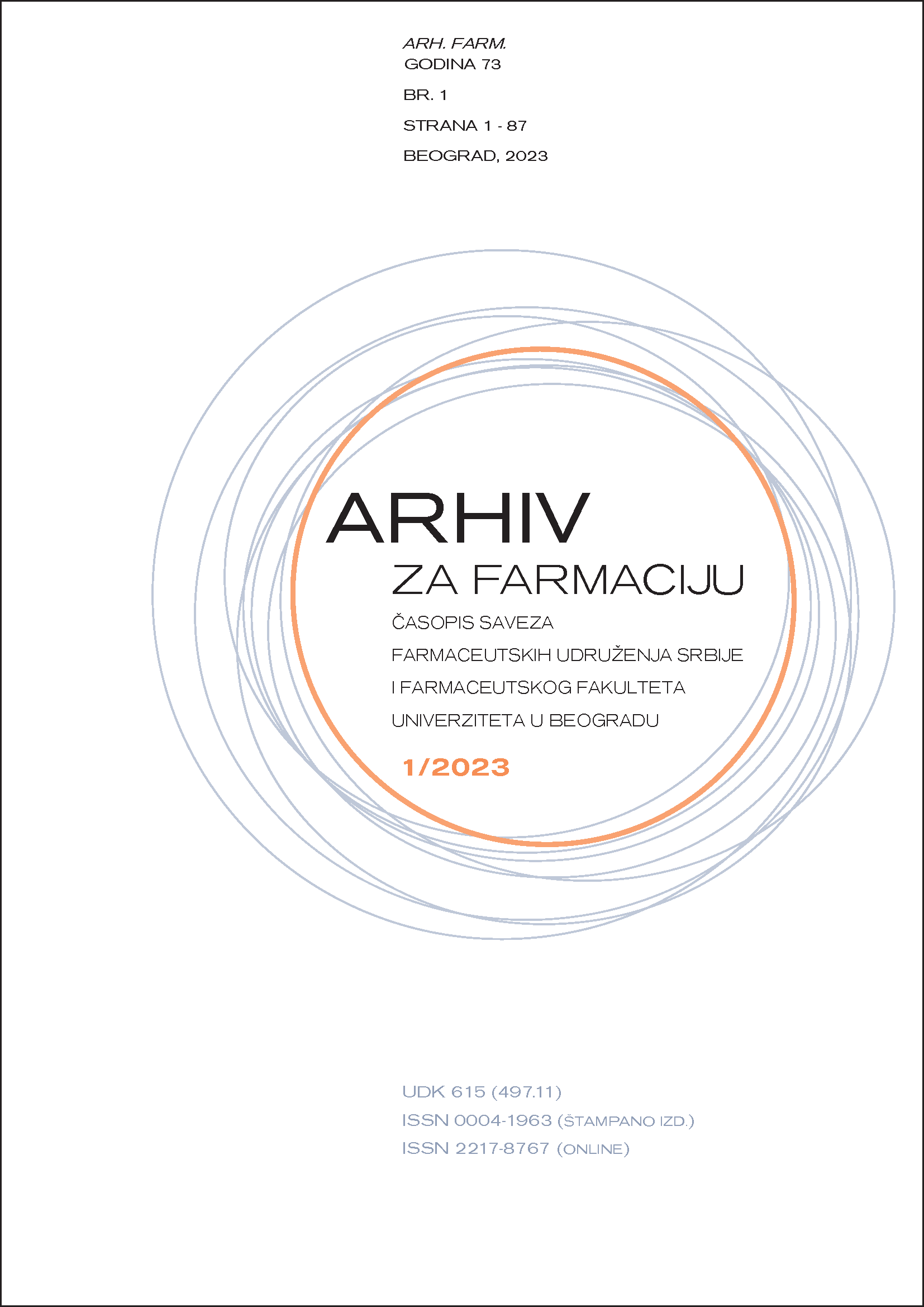Uporedna studija o proceni rizika elementarnih nečistoća u Montelukast tabletama za žvakanje i filmom obloženim tabletama
Sažetak
Dobro je dokumentovano da su elementarne nečistoće (EN) kritične u oblasti farmaceutskog razvoja jer mogu uticati na kvalitet, efikasnost i bezbednost finalnog oblika leka (FOL). Odgovornost proizvođača farmaceutskih proizvoda je da pokažu, preko pristupa procene, strategije kontrole zasnovane na riziku, i/ili potrebne analize podataka, da su FOL usaglašeni sa ICH Q3D (R2). Bez obzira na to, praktična primena ICH Q3D (R2) smernice i usklađenost FOL-a sa ICH Q3D (R2) uvek predstavljaju izazov za farmaceutsku industriju. Cilj ovog istraživanja je da se sprovede detaljna komparativna studija procene rizika od EN za tri različita dozirana oblika Montelukasta proizvedenih kao tablete za žvakanje (4 mg i 5 mg) i film obložene tablete od 10 mg. Sistem induktivno spregnute plazma-masene spektrometrije (ICP-MS) korišćen je za određivanje EN u uzorcima montelukast natrijuma, kao aktivne komponente, placeba za sve FOL i FOL. Nakon toga, analize su takođe sprovedene na tri serije iz sva tri proučavana FOL-a. Na osnovu ICH Q3D (R2) smernice, testirani proizvodi za EN, klasa 1 i klasa 2A pokazali su da su nivoi EN u aktivnoj komponenti i placebu znatno ispod oralnih i parenteralnih granica ICH Opcije 1. Za ispitivane serije svake FOL jačine (ukupno 9), nijedan EN ne prelazi njihove granice koncentracije.
Reference
1. International Council for Harmonization of Technical Requirements for Pharmaceuticals for Human Use - ICH Harmonized Guideline for EIs Q3D(R2). 2022.
2. European Medicines Agency (EMA). Committee for Human Medicinal Products. ICH guideline Q3D on EIs. EMA/CHMP/ICH/353369/2013. 2015.
3. EDQM EU [Internet]. European Pharmacopoeia (Ph. Eur.). 10th Edition | EDQM - European Directorate for the Quality of Medicines [cited 2022 Feb 20]. Available from: <https://www.edqm.eu/en/european-pharmacopoeia-ph-eur-10th-edition>
4. USP 35 [Internet]. United States Pharmacopeia and the National Formulary (USP 35 - NF 30). Rockville (MD): The United States Pharmacopeial Convention [cited 2022 Feb 20]. Available from: https://www.usp.org/.
5. Barin JS, Mello PA, Mesko MF, Duarte FA, Flores EM. Determination of elemental impurities in pharmaceutical products and related matrices by ICP-based methods: a review. Anal Bioanal Chem. 2016;408(17):4547-66.
6. Gandhi HM, Gollapalli NR, Lilakar JK, Jain KK, Mohanty S. Isolation and identification of a potential unknown impurity in montelukast drug substance resulting from photolytic degradation. Anal Methods. 2016;8,1667-73.
7. Emerce E, Cok I, Degim IT. Determination of the impurities in drug products containing montelukast and in silico/in vitro genotoxicological assessments of sulfoxide impurity. Toxicol Lett. 2015;238(2):90-9.
8. Balabanova B, Boev B, Mitrev S, Ivanova V. Method for determination of 35 elements content in various samples with the application of microwave digestion and inductively coupled plasma with mass spectrometry (ICP-MS). Journal of Agriculture and Plant Sciences. 2015;13(1):99-112.
9. Teasdale A, Chéry CC, Cook G, Glennon J, Lee CW, Harris L, et al. Implementation of ICH Q3D EIs Guideline: Challenges and Opportunities. Pharm Technol. 2015;39(3):36-49, 89.
10. Rowe RC, Sheskey PJ, Quinn ME. Handbook of Pharmaceutical Excipients. 6th Edition. Pharmaceutical Press. 2009.
11. Jenke DR, Stults CL, Paskiet DM, Ball DJ, Nagao LM. Materials in Manufacturing and Packaging Systems as Sources of Elemental Impurities in Packaged Drug Products: A Literature Review. PDA J Pharm Sci Technol. 2015 1/2;69(1):1-48.
12. Internal data of the Manufacturer (available if necessary): statements received from suppliers, manufacturing instructions, packaging instructions, specifications, and results of the analysis.
13. Directive (EU) 2018/852 of the European Parliament and of the Council of 30 May 2018 amending Directive 94/62/EC on packaging and packaging waste (Text with EEA relevance).
14. European Parliament and Council Directive 94/62/EC of 20 December 1994 on packaging and packaging waste - OJ L 365, 31.12.1994, p. 10–23 (ES, DA, DE, EL, EN, FR, IT, NL, PT).
15. Regulation (EC) no. 1935/2004 of the European Parliament and of the Council of 27 October 2004 on materials and articles intended to come into contact with food and repealing directives 80/590/EEC and 89/109/EEC [Internet] [cited 2022 Sep 30]. Available from: https://www.legislation.gov.uk/eur/2004/1935/contents.>
16. Commission regulation (EC) no 2023/2006 of 22 December 2006 on Good Manufacturing Practice for materials and articles intended to come into contact with food (text with EEA Relevance) [Internet] [cited 2022 Sep 11]. Available from: https://www.legislation.gov.uk/eur/2006/2023/adopted.>
17. Commission regulation (EU) no 10/2011 of 14 January 2011 on plastic materials and articles intended to come into contact with food (Text with EEA relevance) [Internet] [cited 2022 Sep 12]. Available from: https://www.legislation.gov.uk/eur/2011/10/2020-12-31
18. Annex 5 supplementary guidelines on good manufacturing practices for heating, ventilation, and air- conditioning systems for non-sterile pharmaceutical dosage forms [Internet]. Docslib [cited 2022 Sep 10]. Available at: https://docslib.org/doc/4637981/annex-5-supplementary-guidelines-on-good-manufacturing-practices-for-heating-ventilation-and-air-conditioning-systems-for-non-sterile-pharmaceutical-dosage-forms.>
- Autori zadržavaju autorska prava i pružaju časopisu pravo prvog objavljivanja rada i licenciraju ga "Creative Commons Attribution licencom" koja omogućava drugima da dele rad, uz uslov navođenja autorstva i izvornog objavljivanja u ovom časopisu.
- Autori mogu izraditi zasebne, ugovorne aranžmane za neekskluzivnu distribuciju članka objavljenog u časopisu (npr. postavljanje u institucionalni repozitorijum ili objavljivanje u knjizi), uz navođenje da je članak izvorno objavljen u ovom časopisu.
- Autorima je dozvoljeno i podstiču se da postave objavljeni članak onlajn (npr. u institucionalni repozitorijum ili na svoju internet stranicu) pre ili tokom postupka prijave rukopisa, s obzirom da takav postupak može voditi produktivnoj razmeni ideja i ranijoj i većoj citiranosti objavljenog članka (Vidi Efekti otvorenog pristupa).

